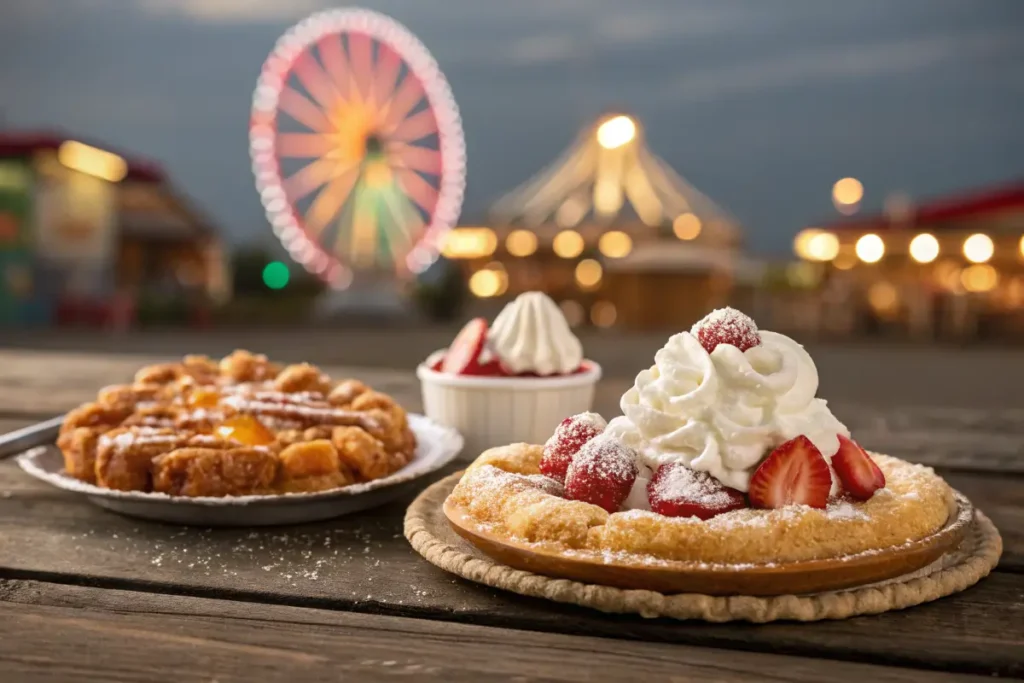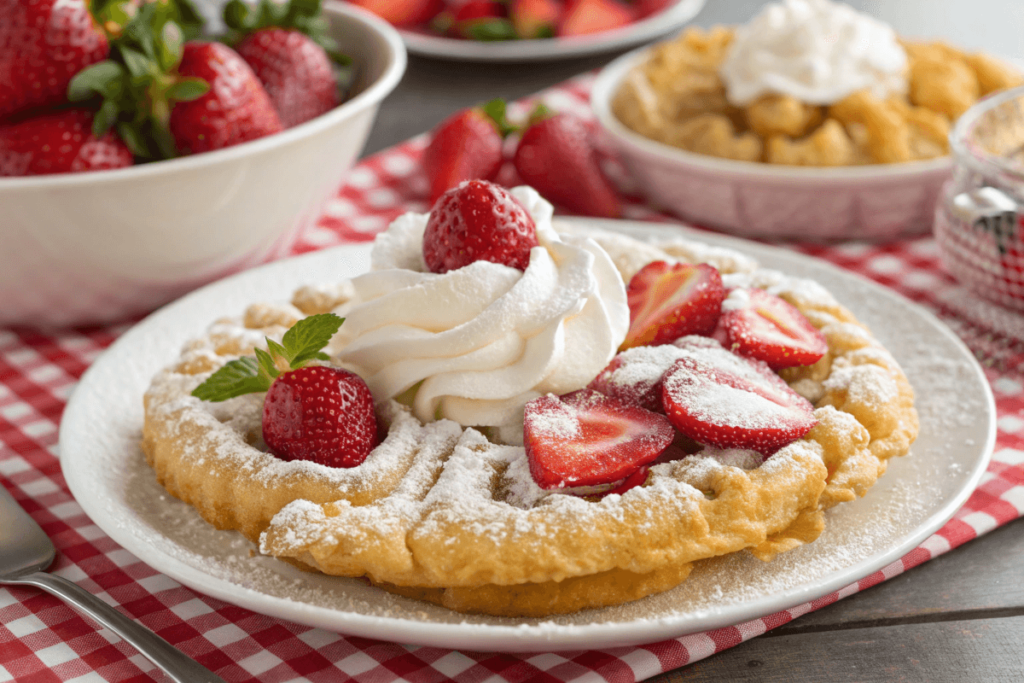Table of Contents
Fairs and carnivals are synonymous with mouthwatering treats like fried dough and funnel cake. These delicacies have become staples of festive gatherings, evoking nostalgia with every bite. But while they share similarities—both being deep-fried and often dusted with powdered sugar—they have distinct characteristics. In this article, we’ll explore what sets them apart, their cultural roots, and even how you can recreate them at home. So, is fried dough the same as funnel cake? Let’s dive in and find out!
Introduction to Fried Dough and Funnel Cake
What is Fried Dough?
Fried dough, also called elephant ears in some regions, starts as a flat piece of yeast dough that cooks deep-fry until golden and crispy. They often coat it with powdered sugar, cinnamon sugar, or even honey after cooking. This simple yet satisfying treat has been around for centuries, appearing in various forms across different cultures. From fairs to food trucks, fried dough is a universal favorite.
What is Funnel Cake?
Unlike fried dough, cooks prepare funnel cake using a runny batter instead of kneaded dough. They pour the batter through a funnel into hot oil, creating its iconic lacy, nest-like shape. After frying, they top it with powdered sugar or other sweet toppings like fruit, whipped cream, or chocolate sauce. Funnel cake’s unique texture is both crispy and tender, offering a different experience than its fried dough cousin.
Popularity of Both at Fairs and Carnivals
You can’t stroll through a state fair without catching the mouthwatering aroma of fried dough or funnel cake. These treats are crowd-pleasers, embodying the spirit of fun and indulgence. Whether it’s the crisp exterior of fried dough or the delicate crunch of funnel cake, each bite brings a sense of nostalgia and joy, making them iconic carnival foods.
Key Differences Between Fried Dough and Funnel Cake

Shape and Texture Differences
One of the most striking differences between fried dough and funnel cake lies in their shape and texture. Fried dough is typically a flat, circular disc, while funnel cake boasts a delicate, web-like design. This intricate pattern in funnel cake gives it a crispier texture compared to the slightly chewy and puffy texture of fried dough. People instantly recognize these distinctions at fairs and carnivals, which often leaves them wondering, Is fried dough the same as funnel cake?
Ingredient Variations: Dough vs. Batter
The fundamental difference between the two starts with their base.Cooks make fried dough using a yeast-based dough, kneading and resting it to activate the yeast. In contrast, they prepare funnel cake with a liquid batter that doesn’t require yeast. They pour the batter directly through a funnel into hot oil, which gives the treat its name. The difference in base ingredients contributes to their unique textures and flavors. For more on frying techniques, you can explore this guide on choosing the best oil for fried dough.
Cooking Techniques
Cooks typically roll out fried dough flat and fry it in hot oil, which creates a uniform and golden-brown exterior. In contrast, they drizzle funnel cake batter into the oil to achieve its signature lacy form. Both require precise temperature control to avoid greasy results, but the visual spectacle of pouring batter for funnel cakes adds an extra layer of fun to their preparation.
Similarities That Link Fried Dough and Funnel Cake
Shared Historical Roots
Both fried dough and funnel cake trace their roots back to ancient civilizations, where frying was one of the earliest cooking methods. The Pennsylvania Dutch community originated funnel cake, while nearly every culture has its own variation of fried dough. This shared history highlights how people have cherished and adapted frying techniques over centuries.
Common Ingredients Used in Both
Despite their differences in preparation, fried dough and funnel cake share basic ingredients like flour, sugar, and oil. Whether you’re biting into the crispy strands of a funnel cake or savoring the chewy texture of fried dough, the use of simple, pantry staples is a testament to their universal appeal.
People often top these treats with similar sweet additions, such as powdered sugar or chocolate drizzle, delighting dessert lovers everywhere.
Universal Appeal as Comfort Food
Why do people love fried treats so much? It’s the warm, satisfying comfort they provide. Fried dough and funnel cake evoke feelings of nostalgia and indulgence. Whether at a state fair or a theme park, they’re a must-try. This shared status as quintessential carnival food highlights their ability to bring people together over a shared love of crispy, sweet treats.
Cultural and Regional Variations
American Variations: State Fair Staples
In the United States, fried dough and funnel cake are beloved staples of state fairs and carnivals. While fried dough is often referred to as elephant ears in the Midwest, funnel cake retains its iconic name nationwide. Both are topped with regional twists—think maple syrup in Vermont or a drizzle of chocolate in California. Their presence at fairs underscores their cultural significance, evoking memories of carefree summer days.
Comparison to International Fried Dough Treats
Globally, variations of fried dough abound, each offering a unique cultural spin. In Italy, zeppole are small, airy fried dough balls dusted with powdered sugar, while in Mexico, buñuelos are thin and crispy, often topped with cinnamon sugar. Meanwhile, funnel cake bears a striking resemblance to jalebi, a popular South Asian treat made from fermented batter and soaked in sugar syrup. These international variations highlight the universal appeal of fried snacks, raising the question: Is fried dough the same as funnel cake across cultures?
Unique Twists in Different U.S. States
Regional adaptations within the U.S. further illustrate how these treats have evolved. In the South, fried dough might be served with a side of honey butter, while in the Northeast, funnel cakes are commonly topped with fresh berries and whipped cream. These regional distinctions add a local flavor to a universal indulgence, ensuring every state fairgoer gets a taste of something special.
For more delicious fried treats, you can explore this guide to the best fried dough recipes.
How to Make Fried Dough and Funnel Cake at Home
Essential Ingredients and Tools
Making these carnival favorites at home requires just a few simple ingredients. For fried dough, you’ll need flour, yeast, sugar, salt, and water. Funnel cake, on the other hand, calls for flour, eggs, sugar, milk, and baking powder. Essential tools include a deep fryer or large skillet, a thermometer to monitor oil temperature, and a funnel or piping bag for the funnel cake.

Step-by-Step Recipe for Funnel Cake
To make funnel cake, mix the batter until smooth. Heat oil in a deep pan to around 375°F. Pour the batter through a funnel in circular motions into the oil. Fry until golden brown, then remove and drain on paper towels. Dust with powdered sugar, or get creative with toppings like fruit and whipped cream.
Step-by-Step Recipe for Fried Dough
For fried dough, roll the yeast-based dough into flat circles. Heat oil to 375°F and fry each piece until puffed and golden. Drain on paper towels and top with powdered sugar, cinnamon sugar, or even a drizzle of chocolate. The result is a crispy-on-the-outside, chewy-on-the-inside delight.
These recipes allow you to bring the joy of fairs and carnivals into your kitchen. For more cooking tips, check out our site for inspiration!
Nutritional Comparison and Health Considerations
Caloric and Fat Content Analysis
When it comes to indulgent treats, both fElephant ears and funnel cake are calorie-dense. Fried dough tends to be slightly higher in calories due to its thicker, denser nature, often requiring more dough and oil. Funnel cake, though lighter, has a large surface area, which can absorb plenty of oil during frying. A typical serving of either can range from 300 to 600 calories, depending on portion size and toppings. If you’ve ever wondered whether fried dough and funnel cake are the same nutritionally, you’re not alone! The answer is, not exactly, but both pack a similar punch in terms of fats and sugars.
Are There Healthier Versions?
If you’re craving these classics but looking for a lighter option, you’re in luck! Baked versions of fried dough and funnel cake can significantly reduce fat content without compromising flavor. Additionally, using whole wheat flour, sugar substitutes, or air frying can make these treats more health-conscious. Topping your creations with fresh fruit instead of sugary syrups can also cut back on added sugars. With a little creativity, you can enjoy the best of both worlds—delicious flavor with fewer calories.
Frequently Asked Questions
What Makes Funnel Cake Unique?
Funnel cake’s unique, lacy structure sets it apart. The batter is poured in swirling motions, creating a crispy yet airy texture that’s unlike any other fried treat. Its iconic look and versatility in toppings make it a standout at fairs.
Can Fried Dough Be Sweet or Savory?
Absolutely! While fried dough is often topped with powdered sugar or cinnamon, it can also be served savory. Some variations include cheese, garlic butter, or even marinara sauce for dipping, proving its adaptability in both flavor profiles.
Are Elephant Ears and Fried Dough the Same?
Yes, elephant ears are a regional name for fried dough. Their large, flat shape resembles an elephant’s ear, but the recipe and cooking method are identical to traditional fried dough.
What Are Popular Toppings for Both?
Powdered sugar is a classic choice, but the possibilities are endless. You can drizzle chocolate, caramel, or fruit sauces over either treat. Whipped cream, fresh berries, or even sprinkles add a festive touch.
If you’ve ever wondered whether fried dough and funnel cake are the same, we hope this deep dive has clarified their delicious differences and similarities!
The Origins and History of Fried Dough and Funnel Cake
Historical Roots of Fried Dough
Fried dough has an ancient history, tracing its roots back to early civilizations. Cultures across the globe have variations of this fried treat, from Native American fry bread to Italian zeppole. The basic recipe—flour, water, and oil—made fried dough an accessible, filling snack for communities throughout history. This long-standing tradition adds to its enduring appeal. So, when you ask, Is fried dough the same as funnel cake?, the historical perspective suggests they’re related yet culturally distinct.
Funnel Cake’s Pennsylvania Dutch Origins
Funnel cake, as we know it, has its roots in the Pennsylvania Dutch community. Inspired by German culinary traditions, funnel cake emerged as a popular festival treat in the 19th century. Its airy, delicate structure contrasted with the dense, chewy texture of fried dough, offering a lighter, sweeter alternative. Over time, this lacy creation became a fairground staple, adored for its crispy texture and endless topping possibilities.
Why These Treats Remain Popular Today
The Allure of Carnival Food
Fried dough and funnel cake embody the spirit of indulgence. Their warm, sugary aroma and satisfying crunch instantly evoke feelings of joy and nostalgia. These treats are more than just food—they’re part of the carnival experience, symbolizing carefree moments with family and friends. This emotional connection ensures their enduring popularity, even as new desserts emerge.
Adaptability for Modern Palates
One reason for their continued appeal is their versatility. Both Elephant ears and funnel cake can be customized to suit modern tastes. From gluten-free versions to gourmet toppings like salted caramel or matcha drizzle, these classic treats have evolved to stay relevant. With home cooks experimenting and chefs offering upscale versions, the question Is fried dough the same as funnel cake? keeps sparking curiosity, fueling their fame.
In conclusion, both fried dough and funnel cake offer something special—be it a chewy, satisfying bite or a crispy, airy texture. Their shared and unique traits ensure they remain beloved across generations. Whether at a fair or in your kitchen, these treats continue to bring smiles and sweet memories.

